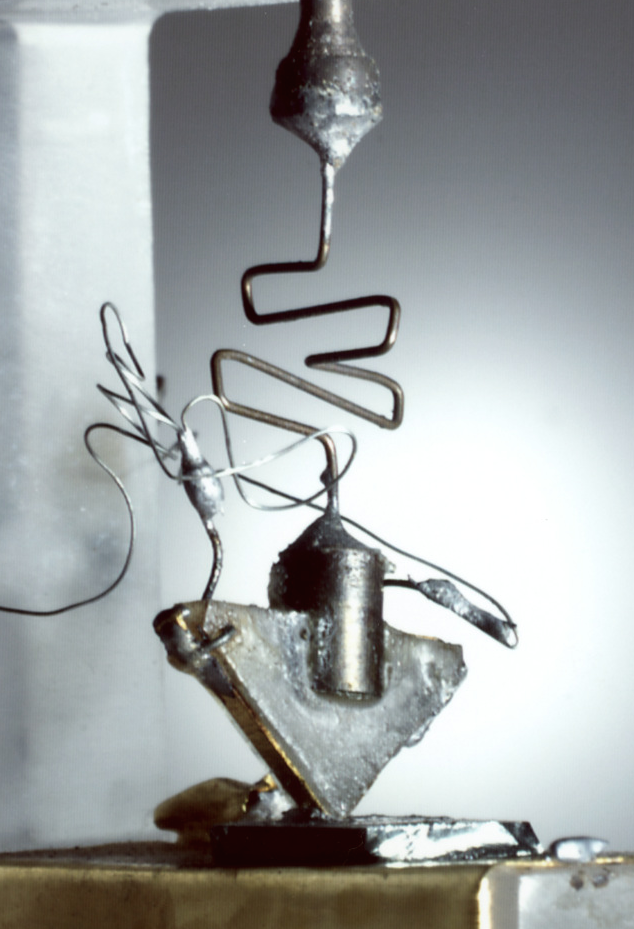
Bucky e o transistor
Conjunto de citações pinçadas de Richard Buckminster-Fuller sobre o transistor.
BUCKMINSTER-FULLER, Richard. 1969. Operating manual for spaceshift Earth. Zurich: Lars Müller Publishers.
Once man comprehended that any tree would serve as a lever his intellectual advantages accelerated. Man freed of special-case superstition by intellect has had his survival potentials multiplied millions fold. By virtue of the leverage principles in gears, pulleys, transistors, and so forth, it is literally possible to do more with less in a multitude of physio-chemical ways. Possibly it was this intellectual augmentation of humanity’s survival and success through the metaphysical perception of generalized principles which may be objectively employed that Christ was trying to teach in the obscurely told story of the loaves and the fishes. (p.17)
BUCKMINSTER-FULLER, Richard; KUROMIYA, Kiyoshi. 1981. Critical path. New York: St. Martin’s Press.
History shows that, only when the leaders of the world’s great power structures have become convinced that their power structures are in danger of being destroyed, have the gargantuanly large, adequate funds been appropriated for accomplishing the necessary epoch-opening new technologies. It took preparation for World War III to make available the funds that have given us computers, transistors, rockets, and satellites to realistically explore the Universe. In the one hour of concentrated introductory reading about the critical path that must be accomplished in order to achieve understanding that we have the option to “make it,” the first thing first is to understand what the world power structures are and of what their unique technical levers and strategies consist. (pp.xix-xx)
The critical path already accomplished in the last fifty years makes all this and much more immediately possible of development. It would not be possible to consider many of these strategies prior to the invention on this planet of certain artifacts: for example, the rocketry-accomplished satellites or recent decades’ proliferation of computers would not have been possible without the discovery of transistors, which would not have been possible without the prior discovery and development of all the discovering and inventing of all history. (See Appendix I.) […] It was, however, possible in 1927 to see that such only-now-in-1980-physically-possible capabilities were and would always be desirable for society. Without being able to predict the discovery of transistors, chips, optical fibers, etc., it was easily possible to dream in 1927 that anything we needed to do could be done — never mind how — and to say to oneself, “I want a device like a fairy wand, which I need only wave while stating audibly the results I wish,” and that this would be accomplished by subvisible, atomic behaviors. Whether this was to be done at the push of a button was of no real consequence. It is what we need and want to do that is reasonable that counts. My fifty-three-year critical path has proven that. I did not just state what was desired. I saw that it was my responsibility to undertake to design the artifacts that would best produce the desired results. Then, as first presented with new discoveries and developments by others, I must redesign my artifacts to take advantage of the now-proven additional technical capabilities. (p.268)
1968 […] U.S. scientists fit 12 million unconnected transistors into 1-inch-square wafer — all demonstrating RBF’s concept of significant evolutionary trending of the more-with-less performance per pounds and volumes of materials and energy used per each function (pp.395-6)
BUCKMINSTER-FULLER, Richard. 1983. Grunch of giants. New York: St. Martin’s Press.
In developing trigonometry and its solution by logarithms, thousand of monks worked for hundreds of years to produce the one-degree tables of sines, cosines, tangents, and cotangents. During the Great Depression years of 1930 to 1936 the British and German mathematicians were hired by their governments in a joint project to calculate the table of functions to a one-minute of arc exactitude. Then came the big post-World War II calculating machines, Univac et al., filling whole university buildings with thousands of thermionic tubes. Then came the tubeless transistor and computers weighing and bulking far less, until we came to printed circuits and “chips” and table-top equipment doing better work than the whole-building-filling equipment. Before all this, I myself spent two pre-calculator or -computer years carrying out the trigonometric calculations for geodesic domes. I had to do so “longhand.” Then appeared seventy-five-pound electric calculating machines, followed by the pocket-size computers with which the trigonometric problems that took me two years of work became solvable in one day by one person. […] This process promises within a few years to become so miniaturized and so comprehensively capable as to be the size of a hearing aid, though able to interact with all the world-around computers and able to discern how best to operate our planet, making obsolete the opinions of corporate or government executives. (pp.33-4)





 O LaSPA é sediado no Instituto de Filosofia e Ciências Humanas (
O LaSPA é sediado no Instituto de Filosofia e Ciências Humanas (